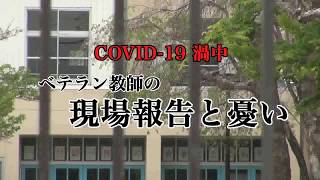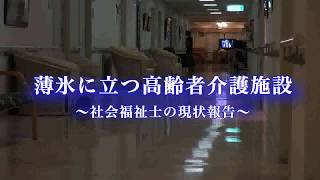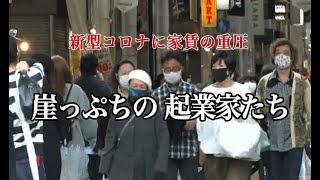Taiwan, Hong Kong, UK & Japan The COVID-19 CrisesApril 2020 onwards
On the Eve of Ten Thousand Cases in Japan: Uncanny Silence Settles in the City of Osaka~
Southeast Asia suffered few human damages from COVID-19. I am planning to investigate why this was so from multiple angles in Vietnam, Cambodia and Thailand, but it seems I cannot go to these countries for a while. I am therefore continuing to report from within Japan. Here are some footages from Osaka under the Declaration of Emergency.
The government requests that we “stay home”, but video and photo shoots cannot be done remotely so I carried out the report, taking necessary preventative measures. Journalists are not asked to shut down their activities. Rather, these are crucial moments for journalism.
This report is for many of you who had stayed home and not been outside for a while.
The Woes of an Experienced Teacher: A Report from the School
Uploading another video concerning COVID-19, about what’s going on in the schools. That’s an angle that the media does not take up very frequently, so I’ve asked a middle school teacher of my age to speak out about the realities of the classroom.
Some municipalities have decided to call off schools until the end of May. Meanwhile, only 5% of public schools are able to provide online classes (as reported by the Ministry of Education, Culture, Sports, Sciences and Technology).
Some say that COVID-19 will finally be controlled when there is collective immunity, and if that’s the case, it’s going to take some time. How will our children, who will bear the next generation, be educated?
I can’t sleep; it feels like deserting my colleagues in the face of an enemy if I don’t get up and report about COVID-19 now. As a journalist, I hope I can be of some service.
How to Deal with COVID-19 Stress
The State of Emergency has been extended. There is tremendous pressure to stay inside, in spite of circumstances that call for you to go out or open up your business. The stress keeps mounting. It is true that isolation will extinguish the spread of contagious diseases, however, social withdrawal adversely affects mental health. Perhaps the stress of staying inside erupts in the increasing cases of domestic violence and other socially aggressive behaviors. Some people have even started to coin terms such as “Corona Divorce” and “Corona Depression”.
The third in this series was to ask my old friend, clinical psychologist and university professor, Dr. Akira Ikemi, about “how to deal with COVID-19 Stress”. The interview was recorded by adhering to the guidelines, using masks, sanitizing our hands with alcohol, and social distancing.
Professor Ikemi is bilingual. We also shot an English version.
Welfare Facilities for the Elderly on Thin Ice: A Report from the realities of a health care worker
The WHO (World Health Organization) reported that “the majority of death due to COVID-19 in Europe occurred in the elderly.”
It is already known that some people are asymptomatic with this virus while others with pre-existing conditions and the elderly easily develop serious conditions. In light of this, in Japan, when the disease spreads to high-risk people as in welfare facilities, the press rush to the scene. However, the number of deaths in facilities for the elderly are not in the order of the thousands, as in EU and USA, and available data show only 66 death in these facilities at the end of April.
In EU and USA, when there are no more beds in intensive care units, the triage is used, giving the young priority over the elderly. In Japan, however there is another view of life/death as seen in organ transplants and terminal care. Moreover, from a practical point of view, welfare staff are well trained with drills for Influenza virus and norovirus conducted every year.
Only those facilities where the contagion spread appear in the news, while the facilities that were able to prevent the outbreak of contagion go unreported. The fourth in this series is titled “Facilities for the Elderly on Thin Ice” where I interview a Social Welfare Care Giver who occupy a central role in a facility that provides Day Services, Short Stays and Nursing Homes.
The Strain and Stress of a General Practitioner

“A GP’s office like mine will go out of business when there’s just one COVID-19 patient” an internal medicine physician who has been treating me for 3 years told me 2 weeks ago. I asked him if he would like his voice to be aired when I visited him on May 12th. He agreed to be interviewed without a camera and with no microphones. He spoke with me for 15 minutes in such detail that without a memo it would have been impossible to retain the details of what he told me. The physician knows, of course, that I am a journalist.
“People are afraid of a (new) virus and I hope it wouldn’t lead to segregation and discrimination” (against people), he says. He continues saying that “staff members in an internal medicine and in a pediatrics clinic that his colleagues run, were infected with the virus. Public health officials came and disinfected the clinics and both of these clinics were asked to shut down for two weeks. After two weeks, no patients came to these clinics, even those patients who they had treated for many years.
In this clinic: 1) temperatures are checked and symptoms such as throat pain and coughs are inquired upon entrance; 2) patients, doctors, nurses, all staff members wear masks; 3) a maximum of 2 patients are waiting in the waiting area; 4) all doors and windows remain open for ventilation; 5) doorknobs and sofas are disinfected frequently with alcohol; 6) physicians wear goggles and interview patients from a 2-meter distance.
As a physician, he “know how to avoid contagion” and places the sign “Tests for COVID-19 are not conducted here.” This morning he saw 37 patients and couldn’t find to time to spare for testing COVID-19 patients.
As with the rest of the country, the majority of this physician’s patient is elderly. For elderly patients suspected of COVID-19, he does not recommend testing, and recommends them to stay home if their symptoms are not serious. He says that he “can’t imagine the elderly being put into a small hotel room and handed food that doesn’t have much taste “. For patients that he is seeing for many years, he says he knows whether this patient will listen to his recommendations and stay home. Even in times of crises, this physician maintains his assessment of the totality of the person he sees, not only the symptoms.
“The reason there are few deaths in Japan is because of the quality of the physician”. This physician says that many physicians rely on their hunches to prescribe medicine for each patient that would prevent the flare up of their symptoms. “Although the treatment drug for COVID-19 isn’t here yet” he said, naming drugs for pneumonia, asthma, and cerebral infarction. He speculates that “the soaring number of deaths in the west may be due to the fact that good medicines are not paid by insurance and their applications are limited strictly to certain disorders, and thereby lacking the flexibility of use as in Japan.
I took the prescription he wrote for me to a pharmacist who said, “less people are using clarithromycin today. I think they are all careful about their health and they don’t seem to catch a cold”.
At a Secretly Open Bar
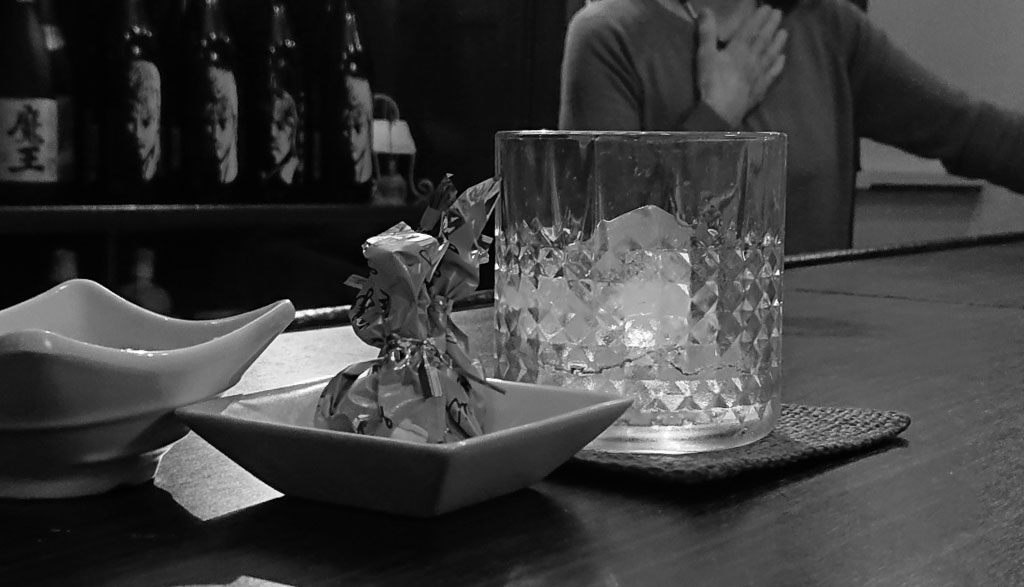
“I don’t care about this life anymore, I’ll go when I have to.”
“But you need you win at the horseraces before you go, dear”.
Such was the conversation between the lady who runs this bar (Sachiko) and a frequent customer last night.
8:30 PM on May 14th, 39 provinces except Tokyo, Osaka and a few provinces came out of the emergency declaration, while this bar was at one of the provinces that remained within the state of emergency. A “snack bar” as it is called here, is considered to be the epitome of the three dangers of contagion—crowded, enclosed and close-proximity. People are lined up on the counter with their masks off to drink; they talk, laugh and sing karaoke. There’s just no way to avoid droplet contagion. This “snack bar” is open secretly as it is still requested that people stay home, and shops remain closed.
Sachiko who is in her fifties was contacted by her employer on May 11th. He is paying the rent and the karaoke fees for the bar. He asked her “if it’s alright with you, isn’t it about time to open?” Sachiko works at a supermarket during the day. Her kids have grown up and she lives alone. “I like delicious food and drinks, but the pay from work during the day can only pay for my rent and phone bills”, she says. Her employer is not reimbursing her for the time that the bar was not open, and public compensation funds did not apply, and thus her decision to secretly open the bar. There are people acting like self-styled police officers, accusing people who violate the request to stay home. She has decided to face such accusations should they arise.
The current owner, a fourth-generation owner, has continued this bar which has been in business for more than half a century in front of a private railway station. Undoubtedly, this bar is a classic “snack bar”. The “snack bar” came into being around 1964 when the Tokyo Olympics were held. At the time, the nation tried to clean up its late-night drinking entertainment shops by setting strict regulations on drinking places. These bars escaped strict regulations under the pretext that they were serving snacks, or light food, and they also served alcoholic beverages. But this time, as people’s health and lives are at stake, it may be difficult to get around the regulations.
Still, there are bars that kept open outside the provinces that declared emergency. They required customers to clean their hands with alcohol at the entrance. Signs read “people with higher than normal temperatures and groups of more than three people are not admitted. Please be sure to sanitaize your fingers upon entering. Seats are placed apart for social distance, do not move them. Do not come in contact of 1 meter or closer with each other. Disposable disinfectant paper towels will be provided for the time being.” These items expressing compliance are posted above the bottles of drinks.
It is said that there are more than 100,000 snack bars nationwide, they outnumber convenience stores. But due to COVID-19, many have had management problems and have closed their businesses. In addition, since it seems obvious that restaurants are generally required to avoid sitting face-to-face and customers will need social distance even after the declaration of emergency has been lifted. It thus remains uncertain whether customers will return in the same numbers. The drinking culture of Japan may be in transition
Sachiko also takes her temperature every day and wears a mask and puts a bottle of alcohol at the entrance as she re-opens her bar. She learned that the illuminated sign to the bar was kicked and broken at another bar, hence her signboard has no illumination and no mics when people sing karaoke, in low volume too. The one who was talking with her about horseracing is a chef at a nearby restaurant. “I had only one customer at my place today” he says and laughs. The customers that came here secretly totaled 4 that night, including myself. Far from being an over-crowded and exciting bar.
“Please come again” says Sachiko. I turned down her offer to see me off, mindful that her bar may be harassed if people found out that it was operating secretly. It was pitch black outside. An orange colored light leaked out of the figured glass fixed on this bar since the time it started business.
Entrepreneurs Standing on the Edge of a Cliff
As the 6th report in the series of COVID-19 related reports, I will be listening to entrepreneurs struggle to pay unforgiving tenant fees even though they were forced to close their businesses. The first one is a shamisen player who has opened a shop in Osaka, Minami district in order to enlighten young people and tourists from overseas to the traditional string instrument. The second is an entrepreneur who believes in promoting healthy longevity. He opened a fitness gym 3 years ago in a large commercial facility in Nara. Both entrepreneurs engaged the current trend, inbound tourists and the elderly, but both are now standing on the edge of a cliff due to the COVID-19 infection prevention policy.
By the way, the past 2 reports comprised or my article and still shots. I haven’t written in that style for a while, but I received more feedback from the readers. The video takes more time and energy for editing, but perhaps it makes the readers passive, I don’t know. This report had taken some time for delivery since there were some twists and turns in our appointment scheduling. But since half of it was covered on the video, I had no hesitation in doing the whole assignment on the video. If you have the time, please take a look.
One Hundred Thousand Masks Arrived from Vietnam to Japanese Laborers
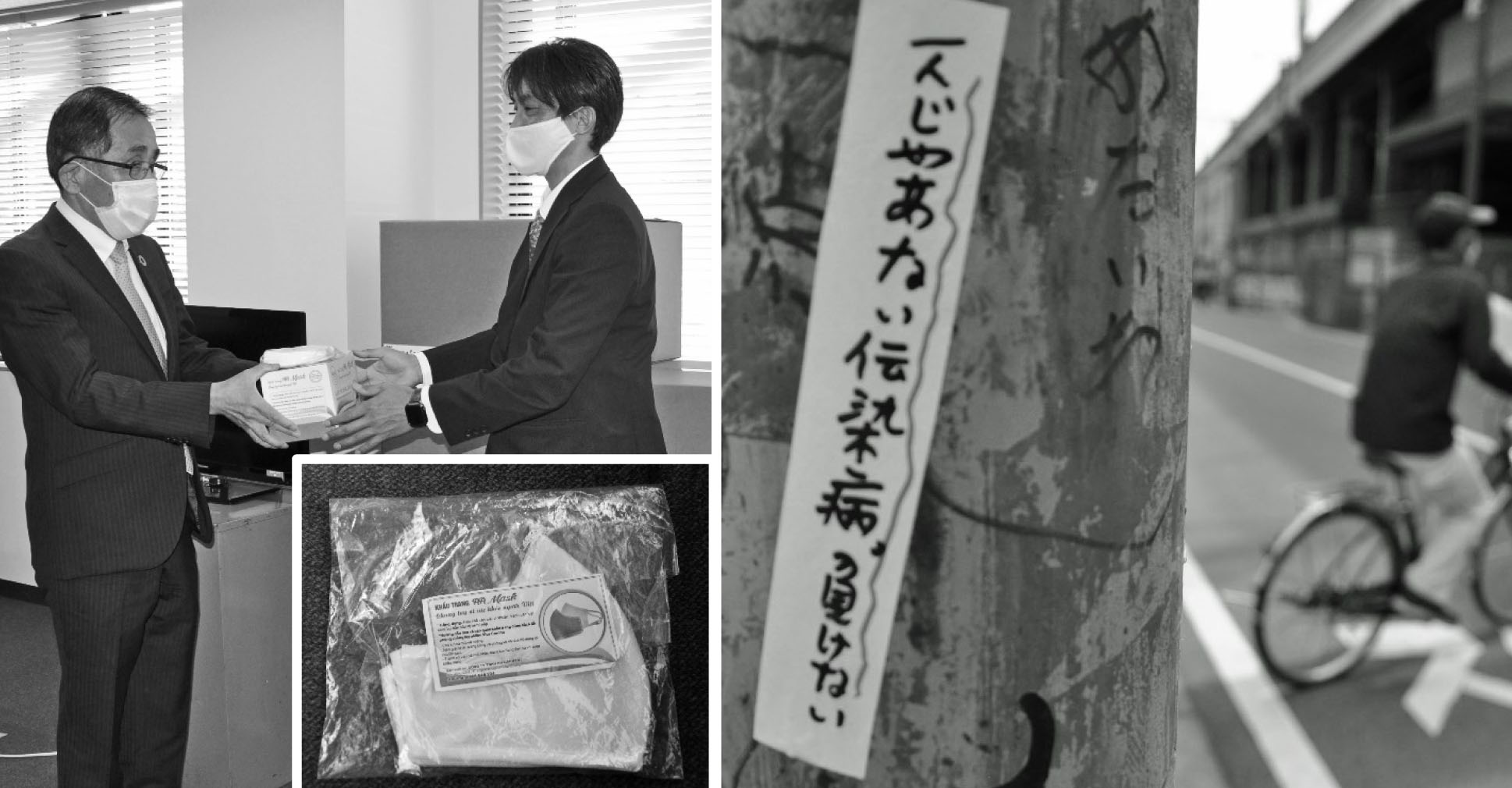
100,000 three-dimensional masks made of four layers of non-woven fabric arrived from Vietnam to Japan.
On May 21st, 10,000 of the masks contained in 10 cardboard boxes were donated to the Airin Distict, a town for day laborers in Nishinari Ward, Osaka. The mask was given by ZUIKO Corporation, a construction company. President Naganori Nishida (43) explained his motive as follows. “Workers are essential to a construction site, but there are many who cannot afford to buy masks, so I am distributing the masks with the hopes that there will be no infections on this site.”
Currently, about 16,000 workers live in the Airin district, and about 90% of them are engaged in construction and civil engineering. The number of people receiving welfare is the highest in Osaka City, and the number of people living on the streets exceeds 1,000, and the aging rate is about to reach 60% (National Institute of Population and Social Security Research). In this area where the number of tuberculosis patients is the highest in the prefecture, people who are likely to become seriously ill when infected with COVID-19 are living shoulder to shoulder.
ZUIKO donated masks to not only the Airin District, but to locations in Osaka, Kyoto, and Shiga prefectures where the it has offices. ZUIKO was able to import a large number of masks from Vietnam, totaling 100,000, because it had strong connections with Vietnam by accepting Vietnamese engineers and technical interns. Mr. Nhat (39), who has worked in Osaka as a technician for 7 years since 2007 has now returned to Vietnam and is now one of the managers of a training center for technical interns. ZUIKO contacted Mr. Nhat in early March and inquired about the purchase of masks. With Mr. Nhat’s central involvement, they were able to select a company that could mass produce high quality masks in a short period of time and to export them to Japan. At the end of March, QUATEST(Quality Assurance and Testing Center) Appraisal Certificate arrived. On April 20, a sample arrived. A contract for 100,000 masks was signed on the 28th, and the masks arrived safely at Kansai Airport on the 15th of May.
These words were printed on the plastic bag that individually wraps the mask. “AA mask. To protect the health of Vietnamese people. It filters bacteria, smoke and dust to protect the respiratory organs. To prevent coronavirus infection, wear it covering both nose and mouth. When reuse, please wash with soapy water. Do not touch the outside of the mask while wearing or removing it. Manufactured HN clothing.” As evident from the Vietnamese inscription, these masks are meant to be used in domestic Vietnam. Although the price of masks is slightly higher than before the COVID-19, it is easily available anywhere in the city. It seems unlikely that the Japanese hoarding of masks created trouble in Vietnam.
Incidentally, since early February, Vietnam has taken thorough measures to prevent infection, such as stopping passenger flights between Vietnam and China and closing off villages where infected people were discovered. As a result, the number of deaths due to the COVID-19 is said to be zero. Mr. Nhat sent this message, “Everyone in every country suffers from COVID-19. We can help each other, of course, in difficult times. Please do your best in Japan.”
In the Airin district, the masks were received by Mr. Koji Uchiya (67), the representative board member of the Nishinari Labor and Welfare Center. The center has been distributing 100 masks every day to day laborers for the prevention of influenza. However, when COVID-19 epidemic was reported, even 400 masks per day became insufficient, and the masks were out of stock before the 7th of last month when the state of emergency was announced in Osaka.
The day the masks were donated was the day when the declaration of emergency in Kansai was lifted. Mr. Uchiya thanked ZUIKO saying that “after the declaration of emergency is lifted, we will have more work, and we would have been out masks” and handed a letter of appreciation to ZUIKO.
In response to the declaration of emergency, general contractors stopped construction of public works, so that those employed in April was minus 30.4% compared to the same month last year, according to the center. The construction sites have been reopened one after another after the first week of May, but Mr. Uchiya was thankful, repeating that “It’s really helpful because some people who didn’t have masks, couldn’t find work.” Some companies make it a condition of employment that workers prepare their own masks.
Many households have not yet received the masks that Prime Minister Abe decided to distribute. It is said that they cost about 200 yen per piece and they are made of gauze. But they will not reach people who live in the Airin district forever, because many do not have a registered address or mailbox. On the other hand, the high-quality masks that the Vietnamese have sent are about 27 yen per piece are in the hands of those who really need them.
Geisha with a Faceguard and mask: What’s happening in Nara where COVID-19 is rapidly surging?
It seemed to me that COVID-19 in Japan will gradually settle down, so I was thinking of returning to Southeast Asia for subsequent interviews, a topic which is my life-work. But just at that time, the number of infected people in Japan exceeded 600 on July 16 for the first time in 3 months. The government decided to exclude Tokyo, where there was a large surge of cases, from the tourist business incentive “GO TO Travel” campaign which started with a row of 4 holidays in July.
Since the entry conditions in Thailand and Vietnam are still severe, I rushed to Nara, one of Japan’s leading tourist destinations, to report on a tourist company that was hit hard. The Chukondo of Kofuku-ji Temple was rebuilt and the coverings came off the Yakushiji east tower, which had been undergoing major repairs. The shrines and temples and shopping arcades once crowded with tourists from abroad are empty.
Nara has been increasing the number of new hotels and nightlife attractions in order to increase the number of tourists staying overnight who spend a lot of money to enjoy the charms of the ancient city at night and early in the morning. Many people were expecting tourists to start returning with the “GO TO Travel” campaign. However, at this point, more than the customers’ health as well as their own, the tourism business became preoccupied with disease prevention and with the government’s strategies for economic recovery.
In this video report, we visited teahouses and ice-candy shops and hotels, which have just reopened their businesses from self-restraint under the declaration of emergency. I listened to what these people had to say. In addition to their main businesses, these are people who have contributed to the economy in Nara. They plan and manage a number of town revitalization events, and they talk with a positive outlook even in the midst of COVID-19. A Maiko (Geisha) shows a Mai (dance) with a mask and face guard. Underneath the traditional make-up is a present day lady. Even such ideas as an “online parlor” is being talked about.


